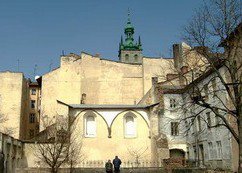Edward Rothstein On Holocaust Children's Objects
"In the exhibition "Life in Shadows: Hidden Children and the Holocaust," which opens today at the Museum of Jewish Heritage, there is nothing intrinsically remarkable about the objects on display. What, after all, is the interest in a stained short-sleeve lime-green sweater that might have been worn by any 8-year-old girl? What is so important about three wooden stubs with ink-drawn faces stored in a battered pillbox?
Yet despite this exhibition's shortcomings, these ordinary objects have an unmistakable aura, as powerful as that of an imposing artwork. Their mundane appearance is loaded with implication; their stains and signs of wear haunt the mind if not the eye. The very fact that they look as if they were plucked from a rummage heap contributes to their power.
For the sweater, with its flimsy lacelike neckline, was worn by Krystyna Chiger in 1943 in the sewers under the streets of Lvov, Poland, where she and her family spent 14 months in hiding as the Nazis liquidated the Jewish ghetto above their heads. And the wooden stubs were made by Jurek Orlowski and his brother - "toy soldiers" with which they played Robin Hood - in a dark flea-infested cellar where they were hidden by a Polish family, before they were discovered and sent to Bergen-Belsen. ...
We think of children in hiding as part of a game, a game that Freud wrote about as if it were the archetypal act of childhood: the child makes things come and go, appear and disappear, affirming some power over the looming, threatening world. What greater power can there be than to make oneself disappear? Hiding also opens new possibilities, in which the solitary child imagines or discovers a new world - lions and witches revealed in the backs of wardrobes.
Only here, of course, everything is inverted: hiding is the sign of absolute powerlessness." ...
Edward Rothstein "Exhibition Review : 'Life in Shadows': Holocaust Children's Objects: Ordinary but Powerful" New York Times January 24, 2006.
"Life in Shadows" continues through June 25 at the Museum of Jewish Heritage, 36 Battery Place, Battery Park City, New York City.

Today's architectural shadows of the L'viv [L'vov] Renaissance-era Rose Synagogue, destroyed by the Nazis.
Photo credit: www.lvivecotour.com
Yet despite this exhibition's shortcomings, these ordinary objects have an unmistakable aura, as powerful as that of an imposing artwork. Their mundane appearance is loaded with implication; their stains and signs of wear haunt the mind if not the eye. The very fact that they look as if they were plucked from a rummage heap contributes to their power.
For the sweater, with its flimsy lacelike neckline, was worn by Krystyna Chiger in 1943 in the sewers under the streets of Lvov, Poland, where she and her family spent 14 months in hiding as the Nazis liquidated the Jewish ghetto above their heads. And the wooden stubs were made by Jurek Orlowski and his brother - "toy soldiers" with which they played Robin Hood - in a dark flea-infested cellar where they were hidden by a Polish family, before they were discovered and sent to Bergen-Belsen. ...
We think of children in hiding as part of a game, a game that Freud wrote about as if it were the archetypal act of childhood: the child makes things come and go, appear and disappear, affirming some power over the looming, threatening world. What greater power can there be than to make oneself disappear? Hiding also opens new possibilities, in which the solitary child imagines or discovers a new world - lions and witches revealed in the backs of wardrobes.
Only here, of course, everything is inverted: hiding is the sign of absolute powerlessness." ...
Edward Rothstein "Exhibition Review : 'Life in Shadows': Holocaust Children's Objects: Ordinary but Powerful" New York Times January 24, 2006.
"Life in Shadows" continues through June 25 at the Museum of Jewish Heritage, 36 Battery Place, Battery Park City, New York City.

Today's architectural shadows of the L'viv [L'vov] Renaissance-era Rose Synagogue, destroyed by the Nazis.
Photo credit: www.lvivecotour.com


0 Comments:
Post a Comment
<< Home